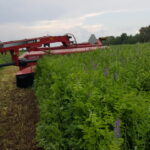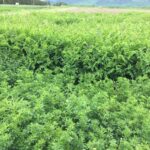Fodder Galega
Galega orientalis
General Description
Fodder galega (pronounced guh-LAY-guh) is a perennial legume. It is winter hardy and tolerant of acidic soils. It can persist for over ten years.
Fodder galega has a large root system. It has a taproot and can spread by underground runners (rhizomes) or reproduce by seed. Galega can grow up to 150 cm (60 in) tall. Primary stems bend at the nodes. Leaves are broader than alfalfa, compound and set on stems. Flowers are purple-blue and grow in an elongated bunch. Five to eight seeds develop per pod, and seeds are kidney shaped.
Do not confuse fodder galega with its close relative goat’s rue (Galega officinalis). Goat’s rue is poisonous to ruminants.
Type
Tame legume.
Origin
Native to the Caucasus region of Europe and Asia (Armenia, Georgia, Azerbaijan, and southern Russia).
Longevity
3-10 years. Galega is slow to establish, so is not recommended for fast rotations where it will be grown for less than three years.
Use
Hay, silage.
Optimal Time of Use
Spring, summer, fall. Fodder galega matures about two weeks earlier than alfalfa or red clover.
Recovery After Use
Fodder galega is suitable for up to two cuts per year. European researchers taking three cuts sometimes report reduced yield.
Expected averages
6.9 tonnes DM/ha (average of Truro, Charlottetown & St. John’s, Fairey et al 2000).
Expected averages
9.7 tonnes DM/ha (Ste Foy, Fairey et al 2000).
Expected averages
Not recommended due to summerkill (Elora, personal communication).
Expected averages
8 tonnes DM/ha.
Expected averages
No yield data available. (Emo, personal communication).
Yield
Note that all yield data is from inoculated plots. Without Rhizobium galegae inoculant, galega yields are approximately half those of inoculated stands.
The long-term fodder galega plots (established 2011) at Lakehead University Agriculture Research Station show that production declines over time, with strong yields for the first 5 production years. Yield dropped by about half in the sixth year and stabilized again for production years 6-10.
Palatability/Nutritional Value
Very palatable to ruminants. Feed value similar to alfalfa or red clover.
Annual Precipitation min/max (mm)
Trials across Canada suggest that galega may not be productive in the semi-arid climate of the central prairies. 500mm / 1550mm
Drought Tolerance
Good drought tolerance.
Flooding Tolerance
Somewhat tolerant of flooding, but does not tolerate waterlogged soils.
Winter Hardiness
Very winter hardy. European research suggests that fodder galega varieties will tolerate air temperatures as low as -20C without snow cover, and -40C when the crowns are insulated by snow.
Soil Texture Preference
Adapted to moist soils of any texture.
Erosion Control
Fodder galega is sometimes used in eastern Europe to protect fallow fields that will be out of production for a few years. However, it is slow to establish, so may not be suited to soils at high risk of erosion.
Salinity Tolerance
Unknown.
Acidity Tolerance
Tolerant of acidic soils above pH 4.5. Grow best in pH above 6.0.
Alkalinity Tolerance
Up to pH 7.5.
Seeds per kg
111,000 to 181,800 seeds/kg (50,455 to 82,635 seeds/lb)
Suggested Mixtures
Canadian trials have been on pure stands only. Fodder galega does not compete well in the establishment year. Researchers in Estonia have had success seeding galega with timothy or smooth bromegrass.
Ease of Establishment
Galega seedlings grow slowly initially, so do not use a companion crop. Weed management ahead of seeding is essential for successful establishment. Early seeding improves yields. Seed as soon as soil conditions are fit to carry equipment in the spring. Seed at a rate of 25-35 kg/ha (22.5-31.5 lb/acre) and 1-2 cm (1/2 to 3/4 in) deep.
Competitiveness
Poor competitor in the establishment year. Once established, galega’s ability to spread by rhizomes helps maintain a thick stand.
Management Considerations
Fodder galega requires its own specific Rhizobium galegae inoculant to fix nitrogen, which is not available in Canada at the time of the eastern Canadian Forage U-Pick release. Some European researchers also recommend scarifying the seeds to improve germination.
Fairey, N.A., L.P. Lefkovitch, B.E. Coulman, D.T. Fairey, T. Kunelius, D.B. McKenzie, R. Michaud, and W.G.Thomas (2000). Cross-Canada comparison of the productivity of fodder galega (Galega orientalis Lam.) with traditional herbage legumes. Canadian Journal of Plant Science. 80:793-800.
Lattemae, P., H. Meripold, U. Tamm, and S. Tamm. (2013). The effect of different fodder galega-grass mixtures and nitrogen fertilization on forage yield and chemical composition. Grassland Science in Europe. 18:168-170.
Sahota, T.S. Annual reports from 2016 to 2021 for the Thunder Bay Agricultural Research Station/Lakehead University Agricultural Research Station.
Varis, E. 1986. Goat’s rue (Galega orientalisLam.), a potential pasture legume for temperate conditions. Journal of Agricultural Science in Finland. 58:83-101.
Zarczynski, P.J., S. Sienkiewicz, J. Wierzbowska, and S.J. Krzebietke (2021). Fodder galega – a versatile plant. Agronomy. 11:1797-1809.
NA

